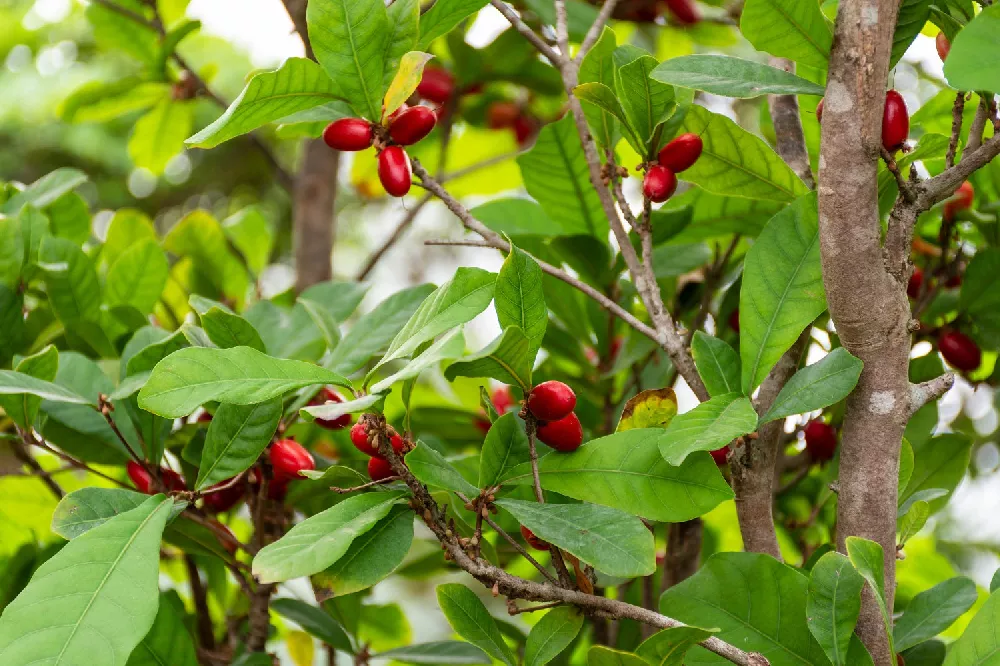Miracle Fruit Plants for Sale - Buying & Growing Guide
- Ships in 1-2 days
- 1-Year Warranty Eligible
- Pots or accessories are not included unless specified in the product options.
Shipping Details:
Once your order is shipped, you’ll receive an email with a tracking number and estimated delivery date. Most orders ship immediately, but some items are seasonal and may only ship in spring or fall. These products are noted on the website.
Miracle fruit plants, which also go by Synsepalum dulcificum, get their common name from the remarkable fruits they hold. These small red berries have an astounding ability to change the flavor of other foods. While miracle fruit berries have a mild sweetness of their own, they can also alter the flavor of sour foods, like lemons and other citruses, to make them taste surprisingly sweet on your tongue. Growing these plants takes some special attention, but if you do it right, your garden will boast some of the most incredible fruits in the world.
- Glossy berries that can change the flavor of other foods.
- Small size allows for container gardening.
- Long harvest season from spring to fall.
Plant Care
Sunlight

Miracle fruit plants grow in areas of either full sun or partial sunlight.
Watering
Consider watering weekly or more to ensure the soil does not have any chance to dry out.
Fertilizing

Provide diluted fertilizer regularly but in low volumes. Balanced fertilizers will work well in most cases.
Planting and Care
Planting instructions
Growing a miracle fruit plant in a container is the best option for many, especially those that live in colder regions. This species will survive year-round outdoors in zones 9 through 11. However, in colder zones, you’ll have to overwinter this plant by moving it and its container inside when the colder seasons arrive. When planting a miracle fruit plant, avoid fertilizing immediately, as these plants often react negatively to receiving too much fertilization. Provide plenty of water after planting to ensure proper soil moisture.
Watering and nutrients
In general, you should never allow this plant’s soil to become dry. To avoid this, give your plant water about once per week — or more if you feel it is necessary. Miracle fruit plants can also be somewhat picky about fertilization, as too much will cause it to decline. The best approach is to apply a diluted and well-balanced fertilizer in small amounts. But while you should give moderate amounts of fertilizer during each feeding, you’ll also need to remain consistent in doing so by fertilizing in this manner about once per month.
Pollination
Without pollination, you cannot expect your miracle fruit plant to produce any of the fruits for which it is famous. Miracle fruit plants are self-pollinating, which generally makes pollination easier. However, if you primarily grow this plant indoors, it won’t have access to natural means of pollination. The solution is to perform hand pollination. One of the best ways to do this is to use a paintbrush or cotton swab to move pollen from the male part of the flower to the female part.
Pruning
While miracle fruit plants can be a bit temperamental when it comes to water and fertilization, the same is not true for their pruning needs. Miracle fruit plants require minimal pruning and may grow to be healthy with little to no pruning at all. Fortunately, this species has a small mature size that is manageable without pruning or shaping. If you choose to prune your miracle fruit plant, don’t remove too much of the plant. Focus on branches that are distinctly damaged or dying.
Pests, diseases, and animals
Another benefit of growing a miracle fruit plant is that you won’t need to worry about diseases. This plant shows an admirable resistance to most fungal and bacterial infections. However, pest issues are another matter entirely. Several pests, including spider mites, can attack this plant. When a pest infestation occurs, you can expect to see damage to both the foliage and the fruits of this plant. The good news is you can often remove these threats by applying insecticides to your plant.
Harvesting
Miracle fruit plants have a long harvest time that can last from the late spring all the way into the fall. When the berries of this fruit are ready for harvest, they will remain small but have a deep red and glossy appearance. The best way to remove these berries is to use shears or a pair of scissors to cut them off. Cutting the berries from the plant reduces harm to the plant, allowing it to continue its healthy growth following the harvest season.
Achieving maximum results
Soil conditions have a lot to do with the success of a miracle fruit plant. Along with the specific fertilization needs of this plant, you’ll also want to ensure an acidic environment. Generally, a pH that falls between 5 and 6. Often, you can use fertilizers made for azaleas and other acid-loving plants if your soil pH is too high. But as always, you’ll want to avoid over-fertilization with this plant.
FAQs
Where does the miracle fruit plant come from?
The miracle fruit plant comes from tropical regions in West Africa. In that setting, this species enjoys consistent moisture and high average temperatures. If you wish to grow one of these plants, you'll need to mimic that setting, which is why many gardeners in North America will need to grow miracle fruit plants indoors for at least part of the year. But in warmer areas, such as zone 9 and higher, this plant can survive outside with the correct care and attention.
How large does a miracle fruit plant grow?
A miracle fruit plant that grows in the wild can grow to be about 20 feet tall. However, plants that grow in cultivation, particularly those that grow in containers, will usually be much smaller. A mature miracle fruit plant that you grow in your garden will usually be a few feet tall at maturity. The fruits themselves are also quite small. They reach just a few centimeters in length when they are ready to pick.
How often do miracle fruit plants bloom?
One of the great advantages of miracle fruit plants is that they have a long and continuous harvest season. This season matches the ongoing bloom cycle of this plant. In the right setting, a miracle fruit plant will produce flowers and fruits for several months, giving plenty of opportunities for fertilization and harvest.
Compare Similar Products
Customer Reviews
 A very nice plant
A very nice plantI was very. Impressed. Plant was very healthy looking forward to ordering more plants in future
 good
goodArrived in good condition
You can't add more Product Name - Product size to the cart.
OK








